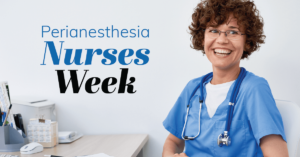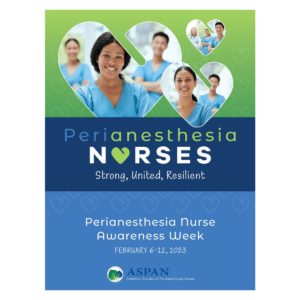The nation’s 60,000 perianesthesia nurses will highlight and celebrate their work during PeriAnesthesia Nurse Awareness Week (PANAW), which is observed throughout the United States the first full week of February.
Perianesthesia Nurses care for patients before and after procedures requiring anesthesia, sedation, and analgesia. Approximately 40 million surgical procedures take place in the U.S. each year.
What are the responsibilities of a perianesthesia nurse?
What Does a Perianesthesia Nurse Do? The main responsibility of a perianesthesia nurse is to monitor patients who are recovering from anesthesia and medical procedures. To do this, they will regularly monitor and record patients’ vital signs, including heart rate, blood pressure, temperature, and respiration rate.
The core ideology of the American Society of PeriAnesthesia Nurses (ASPAN) is to serve nurses “practicing in all phases of preanesthesia and postanesthesia care, ambulatory surgery, and pain management. The National Association of PeriAnesthesia Nurses of Canada (NAPAN©) promotes leadership to PeriAnesthesia nurses (from the PreAdmission/PreOperative Phase through to the Anesthesia Phase and all of the PostAnesthesia phases) in education, research and adapting to evolving practices in client and health services needs within the Canadian health care system.
This type of nursing usually includes at lease a associate degree or in certain hospitals a BSN degree in Nursing plus certifications for this area that has to be renewed q 2 years. The certifications start with getting certified in Basic Care Life Support (BCLS) and Advanced Care Life Support (ACLS). In the United States, RNs can receive specialty certification through the American Society of PeriAnesthesia Nurses (ASPAN) as either Certified PostAnesthesia Nurses (CPAN) or Certified Ambulatory PeriAnesthesia Nurses (CAPA).
n Canada, the Canadian Nurses Association has recently added peri- or post-anesthesia nursing as a certified specialty with the first Certification qualification examination currently being offered (registration fall, 2013 with exam date April 5, 2014). The Canadian certification is PeriAnesthesia Nurse Certified (Canada), or PANC(C).
The work environments these nurses work in consists of a few areas that are critical:
1. Pre-operative – Nurses are responsible for a large amount of the assessment done in pre-operative clinics, where patients (pts or pt)are evaluated for the ability to tolerate anesthetic and screened for factors which may affect the course of the anesthetic experience. The nurses set up up from IV’s started, vital signs, assessment of the pt from head to toe, making sure the pt did not eat for the amount of hours prior to going into surgery. It is doing whatever is necessary prior to a patient having surgery is done from physically and that all paperwork is done in the chart from consents to even labs done within 24 hours or a few days depending on the type of surgery being done if its in a ambulatory day clinic but as a hospital pt labs are usually done that morning 2a or 6a if not further than the day before depending on the reason the pt is in the hospital.
2. Post – operative – Nurses provide extensive care to patients in the early stages of emergence from anesthetic and in the immediate post-operative period until they are deemed stable enough to safely transfer to other areas; which vary from returning back to the room on the unit they are on in the hospital or to the ambulatory room they came from in the hospital where in the end the pt leaves from their and goes home or in some cases leave from straight from the recovery room to home. Nurses in the post – op or recovery room are assessing pts around the clock till cleared stable and cleared by the MD to go home, usually with a driver with them or back to their room.
3. Ambulatory – There is a large number of procedures that are performed on an outpatient basis where the patient is not expected to require hospitalization after the procedure. Examples include dental, gynecological, back surgery where a MD inserts steroid injections in a pt, and diagnostic imaging clinics. Ambulatory surgery usually is micro surgeries.
4 – Pain Management – Pain management nurses are sometimes considered to be perianesthesia nurses, given the collaborative nature of their work with anesthetists and the fact that a large proportion of acute pain issues are surgery related. However, distinct pain management certifications exist through the American Society for Pain Management Nurses.
Peri-anesthesia nursing encompasses several sub-specialty practice areas and represents a diverse number of practice environments and skill sets. Thank you to all the nurses in America and in other countries for your service in caring for patients in this specialty area.

